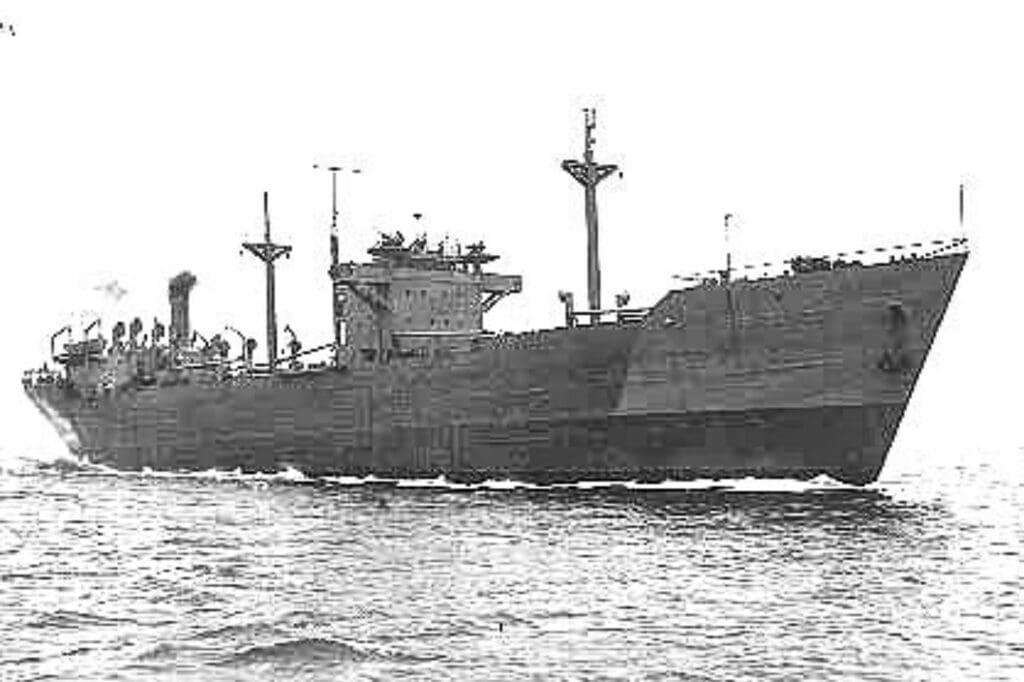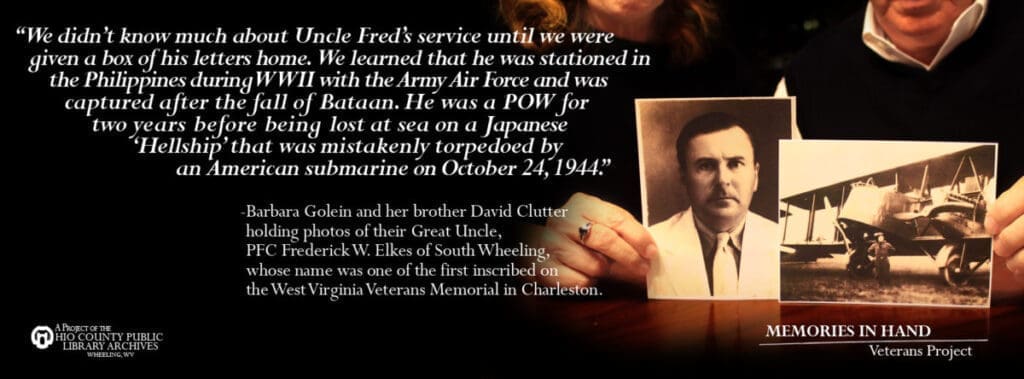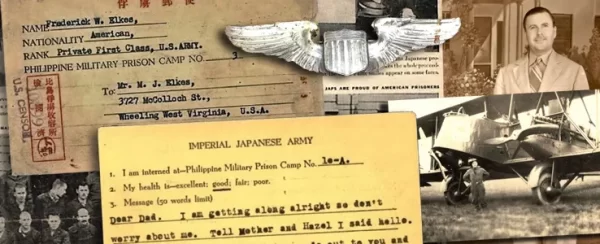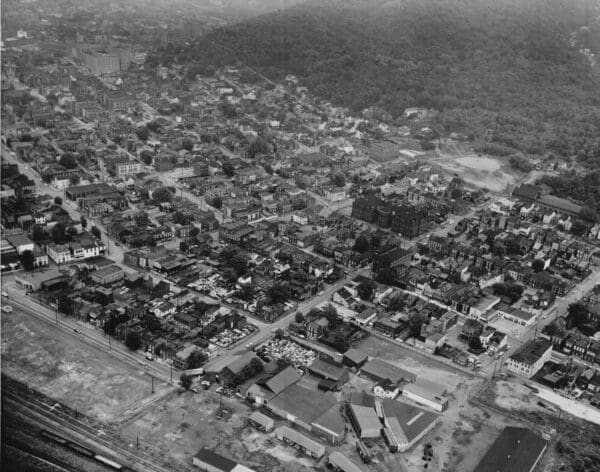The 7,000-ton Japanese freighter, Arisan Maru, is churning toward Formosa. Packed in the stifling heat of the ship’s holds are 1,782 mostly American and some Allied war prisoners of the Empire of Japan. The men are destined for forced labor camps.
Seeing only an unmarked enemy vessel, a U.S. Navy submarine, the USS Shark, fires three torpedoes.
Direct hit.

Among the dead is 42 year-old Private First Class Frederick William Elkes, a 17-year veteran of the U.S. Army Air Force, 17th Pursuit Squadron, 24th Pursuit Group. Stationed in the Philippines, the South Wheeling boy who grew up on McColloch Street, was captured during the fall of Bataan.
The Freddie Elkes Collection

The collection contains letters sent home by Freddie, primarily to his father, hardware store owner Michael Elkes, during Freddie’s years while stationed in the Philippines; letters from the U.S. War Department regarding Freddie’s capture by Japanese Imperial forces after the fall of Bataan and subsequent status as a prisoner of war; censored postcards sent to his father while Freddie was a POW; an assortment of small photographs of Freddie with military planes and a few of his friends; and finally, the heartbreaking letters from the War Department notifying Michael that his son had been lost at sea.
Frederick William Elkes was born in Wheeling on June 24, 1902 to Michael Joseph Elkes and Della Bowman, who later divorced. He had a sister named Hazel. Freddie joined the US Army in 1927 and reenlisted three times. By July 1935, he was stationed as a mechanic at Nichols Field at Rizal, Philippine Islands, with the 28th Service Squadron of the Army Air Corps.
In his letters home from the Philippines, Freddie frequently remarked about the intense heat and the heavy rainfall. Yet, he said, his asthma wasn’t bothering him.

In August 1937, Freddie wrote his father that he was no longer in the Army. He had purchased his discharge in February and was working for the H.E. Heacock Co. of Manila in the refrigeration department. “Japan and China situation looks pretty bad,” Freddie wrote. “I expect most any time for them to call me back in the service again.”
The last letter in the collection from Freddie in the Philippines is dated December 6, 1939, two years before Pearl Harbor. In it, Freddie said he intended to come home sometime in 1940. He asked his father if he had heard from Ruby. “I have written several letters to Texas and they were returned to me.”
The Fall of Bataan
Frederick Elkes was serving in the Philippines when Bataan fell in April 1942. His father received a letter from the War Department dated August 1, 1942. Freddie was officially listed as “missing in action” at that point. The family would not receive official notice from the War Department of Freddie’s prisoner of war status until late January 1943.

Postcards from Behind Enemy Lines

The collection also contains a series of censored postcards from Freddie to his father, with a return address of “Philippine Military Prison Camp #1.” Each provides a brief health checklist and a space for a message limited to fifty words. In one postcard, he said, “Give my best regards to Viola [his father’s second wife]. Tell her to have something good on the stove for I may drop in anytime.” In another of the postcards, Freddie complained that his asthma, which had never been an issue in his time in the Philippines, was now bothering him. He asked for tobacco, papers, and coffee. And as if in reply, in an undated letter addressed “POW Philippine Islands,” Freddie thanks his father for sending “Bull Durham cigarette papers, candy, soluble coffee, and etc.” Japanese characters on the top of the page indicate that the letter was also censored.
Such was the state of communication between Freddie Elkes and his loved ones during his final days.
Bataan

One of the most interesting pieces in the collection is a message in Freddie’s own handwriting on the back of an application by a Chinese merchant for re-admission to the Philippine Islands. It is an official US Immigration form, featuring a photograph of the Chinese merchant. In May of 1945, about a month before he was notified officially that Freddie had been lost at sea, Michael Elkes received the letter from the Provost Marshal General. The cover letter explained that it had been “captured from the Japanese by our Armed Forces during the liberation of the Philippine Islands…These messages were apparently intended for an enemy short wave broadcast.” His captors apparently used whatever paper was on hand, raiding US Government files and forcing prisoners to write these messages for later propaganda use. In his message Freddie recalls the initial attack on Nichols Field on December 7, 1941, which of course, is better known as Pearl Harbor Day. Freddie goes on to explain that he went to Bataan on December 25, 1941 and then to the “beach defense until the day of surrender. April 8, 1941.”
Although, under duress, Freddie wrote the wrong year, we know from this message that he fought at Bataan and was taken prisoner after the surrender in April 1942. This means that Freddie was probably forced to participate in the horrific Bataan Death March, though we have no further documentation to support this. But the probability of it makes his story all the more heartbreaking.
Life & Death on a Hellship
In a letter dated August 25, 1944, Michael Elkes was notified by Col. Howard F. Bresee, Assistant Director of the Prisoners of War Division of the Provost Marshal General’s Office, that Freddie was being transferred to another prison camp. Just two months later, Freddie was aboard the “Hellship” Arisan Moru when she was sunk, as detailed above.
So what were “Hellships,” and what was it like for Freddie Elkes and his fellow POWs on board the Arisan Moru?
By 1944 when Freddie was transported, General MacArthur’s forces were close to the big return to the Philippines as the General had promised, and the Japanese were hurriedly evacuating prisoners. Most were taken to mainland Japan to work as slave labor, often for private companies. They were typically packed into cargo ships. More than 21,000 of the 126,000 POWs transported on such “Hellships” died as a direct result. The Japanese refused to identify these ships as POW transport, so American and Allied submarines often sank them, as happened here. Conditions on board such ships were, indeed, reminiscent of Dante’s Inferno: men were packed into the holds in a standing position in virtual darkness for weeks on the open sea with little room to breathe; the heat and humidity were stifling; there was little water or food; and no toilets meant standing in their own waste for the duration. Men vomited or passed out from the heat. Some died from it. Some suffocated. Others were trampled to death. Their bodies were simply thrown overboard. Those who survived were driven nearly mad by the constant threats from their captors combined with the sounds of explosions of depth charges outside the ship.
Some broke. There were fights among the men. Suicide attempts. Even murders. Survivors reported praying for a torpedo to hit the ship just to end their suffering.
The Arisan Maru was part of a 17 ship convoy. As she lay broken in the water after taking three torpedo hits from the USS Shark submarine, the Japanese guards on board cut the rope ladders to the hold in an attempt to prevent the POWs from escaping. They stood guard with guns ready as the ship slowly sank. Soon, most of the Japanese had abandoned ship and were rescued by a destroyer. Any POWs who approached the destroyer were beaten back. They were left to die, and most of them did, including Freddie Elkes.
<image 7: The letter every parent dreads. OCPL Archives.> It took nearly a year before Michael Elkes received official notice from the War Department regarding his son’s death in a letter dated June 18, 1945.
A Memorial Day Salute: Frederick Elkes.
On this Memorial Day, May 29, 2023, 78 years after the sinking of the Arisan Moru in the South China Sea, we salute the men who died, especially Wheeling’s own, PFC Frederick William Elkes, United States Army Air Corps. Freddie and his comrades sacrificed all and suffered unimaginable horrors in the process. They could not have anticipated the tribulations they would be forced to endure, but they served willingly and bravely in far away lands, knowing they might not survive. We salute them. In an age when words like “courage” and “sacrifice” are breathed all too cheaply and frequently into the common air, we do well to remember these men whose deaths bring meaning and gravitas back to our most hallowed words.
For his honorable service and sacrifice, Frederick Elkes, the South Wheeling boy, was posthumously awarded the Purple Heart. His name is inscribed on the Tablets of the Missing at the Manila American Cemetery in Manila, Philippines. And the name Frederick William Elkes was one of the first inscribed on the West Virginia Veterans Memorial in Charleston.
Memories in Hand: Frederick Elkes

Participate in the Memories in Hand: Veterans Project
Are you a U.S. military veteran from the Wheeling/Ohio Valley area? Do you have a relative or close friend who served?
If so, we invite you to participate in an ongoing project of the Ohio County Public Library Archives called, “Memories in Hand,” a part of our Wheeling Memory Project [link: https://www.ohiocountylibrary.org/history/5039].
If you are veteran, just bring a photo of yourself in uniform. If you are a friend or relative, just bring a photo of your veteran in uniform. If you are also in the photo, that’s great, but not required. And the photo can be from any time period, any war, wartime or not.
We will take a photograph of your hands holding the photograph and create an image, like the example of Frederick Elkes you see above, featuring a brief quote. These images will be made the perfect size for a Facebook cover image, and we encourage you to use them accordingly, especially on Veterans Day and, as appropriate, on Memorial Day.
Just send us an email [link: https://www.ohiocountylibrary.org/contact/email-ocpl/103] or give us a call at 304-232-0244 so that we can arrange a time. Please help us honor the brave men and women who have served our country with “Memories in Hand,” stories through photographs of veterans, by veterans themselves, and the people who love them.
Memories in Hand on Archiving Wheeling: http://www.archivingwheeling.org/blog/memories-in-hand
Sources
Elkes, F. “Frederick Elkes prisoner of war collection.” Ohio County Public Library Archives. Special Collections/Archives 2016-001.
“Hell Ship: Arisan Maru” Bataan Project. https://bataanproject.com/category/hell-ships/arisan-maru/
“Japs Lie About US Heroes.” Life Magazine. Vol. 13. No. 11. September 14, 1942.
Lawton, M. Some Survived: An Eyewitness Account of the Bataan Death March and the Men Who Lived Through It. Algonquin Books. 2004.
Michno, G.F. Death on the Hellships: Prisoners at Sea in the Pacific War. Naval Institute Press. 2001.
Proudfoot, C.N. “Hellships of World War II.” West Virginia Memory Project. http://www.wvculture.org/history/wvmemory/vets/hellships.html. Accessed 11-10-2016.
Saylor, T.S. Long Hard Road: American POWs During World War II. Minnesota Historical Society, 2007.








